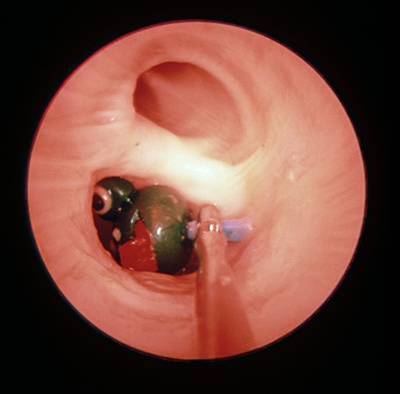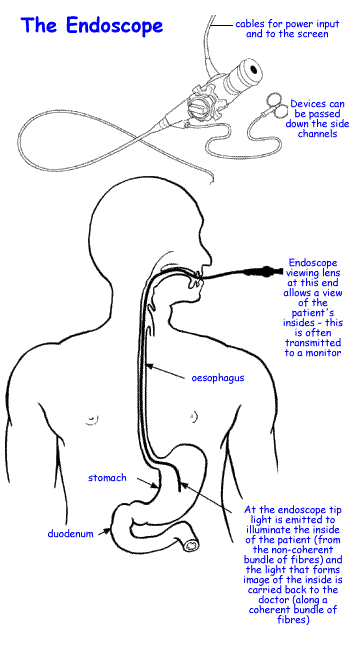Endoscope
An endoscope is a thin, flexible telescope. It is about as thick as a little finger. An endoscope can be passed through the mouth, into the oesophagus and down towards the stomach and duodenum. Or, it can be gently inserted into the rectum and through the colon. For examination purposes you need to know about old fashioned endoscopes: An endoscope consists two light guides. One is a narrow bunch of fibres - coherently arranged - with a lens system at each end. This system of fibres carries the image from the inside of the patient. Light is carried down into the patient by another bunch of optical fibres - these do not need to be coherent as they only are there for illumination. The light from this bundle lights up the inside of the patient and after being scattered by the patient's insides this light returns to the doctor via the coherent bundle.The image can be seen on the lens - but this is often awkward and so this is displayed as a full colour-moving image on a television screen - the results can be recorded for further inspection after the procedure and to be kept as a record for further consultation. Modern endoscopes are cheaper and thinner because they do not need to have the coherent bunch of fibres. They use a bundle of cheaper non-coherent fibres to carry the light into the body and they then have a tiny camera fitted on the tip of the endoscope. This can wirelessly send images to the doctor's monitor. This has not leaked through to exam boards yet - but might be a useful footnote for you in questions. They often ask the question on endoscopes for you to mention the difference between coherent and non-coherent bundles... so do so! This allows a surgeon to see inside a patient without cutting them. This is considerably safer than a surgical investigation - no anaesthetic - no incision! This equipment also makes keyhole surgery possible. Keyhole surgery reduces the risk to the patient by reducing the need for as much anaethetic and reducing the size of incision.
|
Follow me...
|







